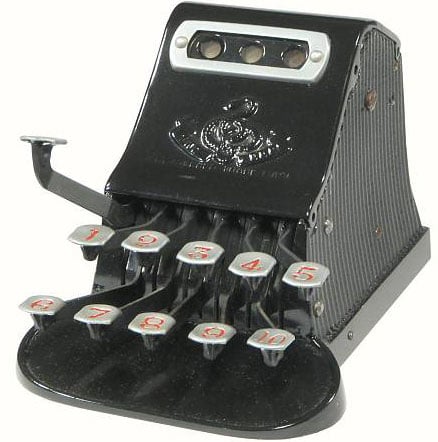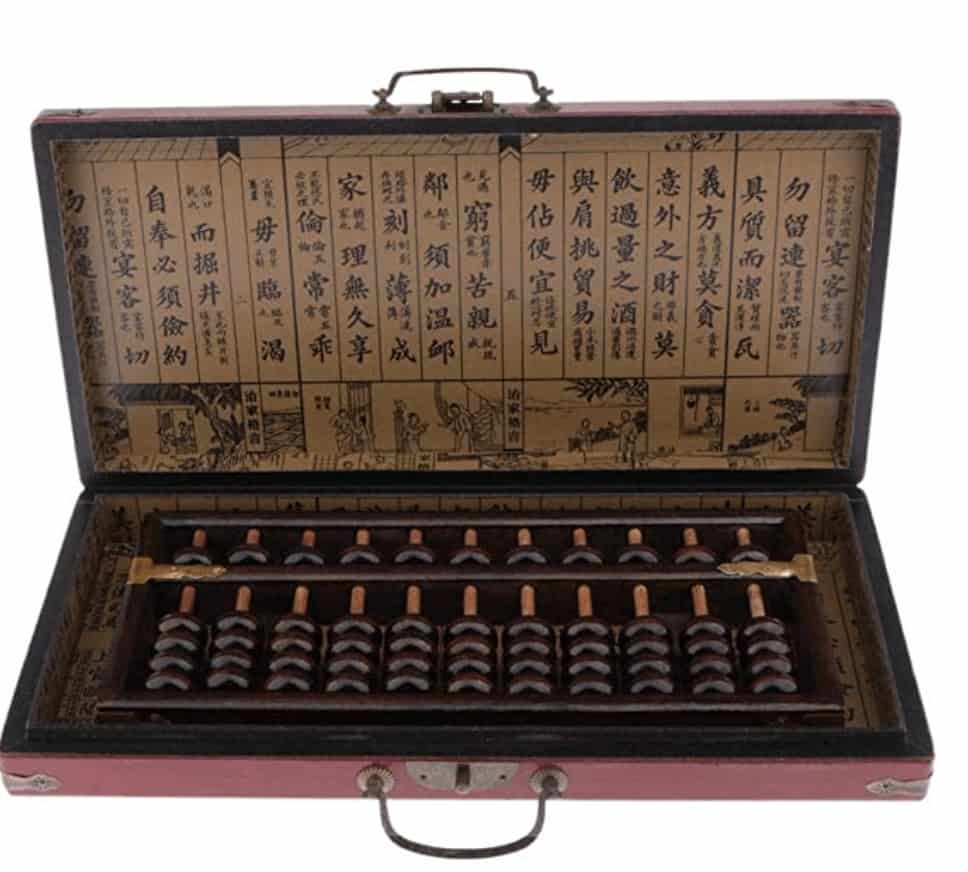From the mid-19th century to the early 20th century, inventors created a variety of mechanical calculators. Some featured nine or 10 keys for entering digits, which wasn’t always the case with earlier mechanical calculators, which sometimes had as few as two keys. As you can imagine, adding columns of numbers with a two-key device was cumbersome at best.
French clockmaker Jean-Baptiste Schwilgué patented a nine-key adding machine in 1844 and displayed it at the Crystal Palace exhibit in London in 1851. Since this machine was never manufactured for sale, it had little impact on the design of adding machines.
Other inventors who proposed or manufactured adding machines with nine or ten keys during that period included David Carroll of PA, Michael Bouchet of KY, Rabbi Judah Levin of MI, and Frank Baldwin of NJ. None of the machines manufactured by these inventors were a commercial success.
Albert Ludlum of CO and William W. Hopkins of MO patented a ten-key adding machine that was unique in that it printed results. This device was manufactured and sold as the Standard adding machine from 1903.
During this same general period (1902 and 1904), British engineer and inventor Arthur James Postans applied for patents for an adding machine. This 10-key device featured three round viewing windows to display digits in the single, ten, and hundred positions. It was intended for adding columns of numbers. The device was manufactured from 1908 until the 1920s.
The Adder of Arthur James Postans
The British engineer Arthur James Postans (1867-1940) from South Kensington, London, applied for a patent for an adding machine in 1902 in several countries. The British patent №GB190224868 (see the lower patent drawing) and the German patent were granted in 1904. The next year Postans obtained a US patent also (patent №786839). Later Postans received patents for the same device, or improved devices, in Canada, Switzerland, Sweden, and three more British patents.
The patent describes an adding machine in which the depression of keys having on them the index numbers moves a series of drums in such a way that the number formed by the position of numerals on their peripheries and appearing through an opening in the casing is increased to the extent of the number appearing on the key that has been depressed.

The machine (see the lower photo) was manufactured by the Adder Cash Register Syndicate Limited of London, England, from 1908 to the 1920s and was sold under the name Adder. The dimensions of Adder are 120 x 180 x 115 mm, weight is 1.71 kg.
The Adder was a single-column single-axis adding machine with three results dials and a ten-key setting mechanism. The three dials are mounted side by side behind the window at the top of the machine. The setting keys are numbered from 1 to 10 and operate on the right-hand (units) dial only. An automatic tens-carry mechanism advances the tens and hundreds dials as required. The clearing lever at the left-hand side returns the three dials to zero.

Who Was the Inventor Arthur James Postans?
Arthur James Postans was born in 1867 in Samford, Suffolk. He was the son of a malster (someone who made malt for brewing) and farmer — Henry Draper Postans (1837-1922), from Stoke by Nayland, Suffolk, and Julia Norman (1841-1921), from Colchester, Essex. Henry and Julia married in 1863 in Colchester, and had three children: besides Arthur, they had another son — John Musgrove (1869-1958), and a daughter — Julia May (1865-1953).
In 1890 Arthur James Postans married in Bloomsbury London to Harriet Mary Cocke (Cooke) (1859-1943). They had two sons: Arthur Norman Fleetwood (1891-1952) and Roy William Clivion Lovegrove (1892-1970), and two daughters: Margery Elizabeth Ellison (1895-1979) and Mary Romara (1895-1963).
Arthur became an experimental engineer and starting from the mid-1890s he was granted numerous patents not only for adding machines but also for other devices like driving gear for velocipedes, an electrical ignition apparatus for internal combustion engines, safety razors, zeroing mechanisms, a stropping machine for razors, an indicator for cash-registers, a printing mechanism for cash-registers.
Arthur’s brother, John Musgrove, was educated at an Ipswich boarding school before following his father and grandfather’s footsteps as a farmer. He won a gold medal in shooting at the 1908 Olympic Games in London.
Arthur James Postans died in 1940 in Alcester, Warwickshire.

